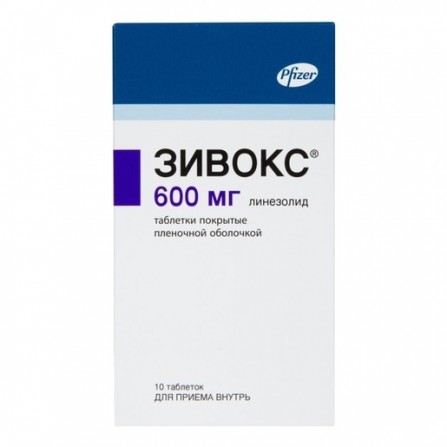More info
Active ingredients
Linezolid
Release form
Pills
Composition
1 tablet contains: Active substances: linezolid - 600 mg. Auxiliary substances: sodium citrate dihydrate; anhydrous citric acid; glucose monohydrate; water for injections
Pharmacological effect
Antimicrobial agent, belongs to the class of oxazolidinones. The mechanism of action is due to selective inhibition of protein synthesis in bacteria. By binding to bacterial ribosomes, linezolid prevents the formation of a functional initiating complex 70S, which is a component of the translation process during protein synthesis. It is active against aerobic gram-positive bacteria: Corynebacterium jeikeium, Enterococcus faecalis (including glycopeptide-resistant strains), Enterococcus faecium (including glycoped phytosis), (glycoprotein-resistant strains), including glycoprotein-resistant strains, Enterococcus faecalis (including glycoprotein-resistant strains), Enterococcus faecium (including glyphs), Enterococcus Faecalis strains), Enterococcus casseliflavus, Enterococcus gallinarum, Listeria monocytogenes, Staphylococcus aureus (including methicillin-resistant strains), Staphylococcus aureus (strains with intermediate sensitivity to glycopeptide s), Staphylococcus epidermidis (including methicillin-resistant strains), Staphylococcus haemolyticus, Staphylococcus lugdunensis, Streptococcus agalactiae, Streptococcus intermedius, Streptococcus pneumoniae (including strains with intermediate susceptibility to penicillin and penicillin-resistant strains), Streptococcus spp. (streptococci groups C and G), Streptococcus pyogenes, Streptococcus viridans; aerobic gram-negative bacteria: Pasteurella canis, Pasteurella multocida; anaerobic gram-positive bacteria: Clostridium perfringens, Peptostreptococcus spp. (including Peptostreptococcus anaerobius); anaerobic gram-negative bacteria: Bacteroides fragilis, Prevotella spp .; Chlamydia pneumoniae. Less active in relation to Legionella spp., Moraxella catarr. , glycopeptides, linkosamides, quinolones, rifamycins, streptogramines, tetracyclines, chloramphenicol, the mechanism of action of linezolid differs from the mechanisms of action of these antibacterial drugs. Resistance to linezolid develops slowly by a multistage mutation of 23S ribosomal RNA and occurs at a frequency of less than 1 × 10–9 –1 × 10–11.
Pharmacokinetics
Linezolid is rapidly distributed in tissues with good perfusion. Vd when reaching Css in healthy volunteers is on average 40-50 liters. Binding to plasma proteins is 31% and does not depend on the concentration of linezolid in the blood. It has been established that cytochrome P450 isoenzymes are not involved in the linezolid metabolism in vitro. Linezolid also does not inhibit the activity of the clinically important cytochrome P450 isoenzymes (1A2, 2C9, 2C19, 2D6, 2E1, 3A4).Metabolic oxidation leads to the formation of 2 inactive metabolites - hydroxyethylglycine (which is the main metabolite in humans and is formed as a result of a non-enzymatic process) and aminoethoxyacetic acid (formed in smaller quantities). Other inactive metabolites are also described. Linesolide is mainly excreted in the urine as hydroxyethylglycine (40%), aminoethoxyacetic acid (10%) and unchanged drug (30-35%). With feces excreted in the form of hydroxyethylglycine (6%) and aminoethoxyacetic acid (3%). Unchanged drug is practically not excreted in the feces.
Indications
Treatment of infectious and inflammatory diseases caused by susceptible to anaerobic and aerobic gram-positive microorganisms (including infections accompanied by bacteremia): community-acquired pneumonia; hospital pneumonia; skin and soft tissue infections; infections caused by Enterococcus spp. (including vancomycin resistant strains of Enterococcus faecalis and Enterococcus faecium). Infections caused by Gram-negative microorganisms confirmed or suspected (as part of combination therapy).
Contraindications
Hypersensitivity to linezolid.
Use during pregnancy and lactation
Adequate and strictly controlled studies of the safety of linezolid in pregnancy have not been conducted. Use of linezolid during pregnancy is possible only in cases where the intended benefit of therapy for the mother exceeds the potential risk to the fetus. It is not known whether linezolid is excreted in breast milk, so if you need to use the drug during lactation, breastfeeding should be stopped.
Dosage and administration
The dosage regimen and duration of treatment depends on the causative agent, localization and severity of the infection, as well as on clinical efficacy. It is administered iv as an infusion in a dose of 600 mg with an interval of 12 hours. The duration of treatment is 14-28 days. the drug was prescribed in / in, in the future can be transferred to any dosage form for oral administration. In this case, the selection of the dose is not required, because oral bioavailability is almost 100%.
Side effects
On the part of the digestive system: often (> 1%) - a perversion of taste, nausea, vomiting, diarrhea, abdominal pain (includingspastic), flatulence, changes in total bilirubin, ALT, AST, alkaline membrane. From the hematopoietic system: often (> 1%) - reversible anemia, thrombocytopenia, leukopenia, pancytopenia. Others: often (> 1%) - headache, candidiasis ; rarely, cases of peripheral neuropathy and optic nerve neuropathy when used for more than 28 days (the relationship between linezolid use and the development of neuropathy has not been proven). Side effects do not depend on the dose and, as a rule, do not require cessation of treatment.
Interaction with other drugs
Linezolid is a weak, reversible, non-selective inhibitor of MAO, therefore, in some cases, linezolid can cause a moderate reversible increase in the pressor action of pseudoephedrine and phenylpropanolamine. With this in mind, with simultaneous use, it is recommended to reduce the initial dose of adrenergic drugs (including dopamine and its agonists) and further to carry out the selection of the dose by titration.
special instructions
With the development of diarrhea on the background of the use of linezolid, the risk of developing pseudomembranous colitis of varying severity should be considered. During the treatment process, a blood test should be performed in patients with an increased risk of bleeding, myelosuppression in history, as well as simultaneous use of drugs that reduce hemoglobin levels and platelet or their functional properties, as well as in patients receiving linezolid for more than 2 weeks.






